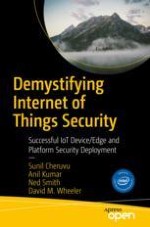Open Access 2020 | Open Access | Book

Demystifying Internet of Things Security
Successful IoT Device/Edge and Platform Security Deployment
Authors: Sunil Cheruvu, Anil Kumar, Ned Smith, David M. Wheeler
Publisher: Apress
Open Access 2020 | Open Access | Book

Authors: Sunil Cheruvu, Anil Kumar, Ned Smith, David M. Wheeler
Publisher: Apress
Break down the misconceptions of the Internet of Things by examining the different security building blocks available in Intel Architecture (IA) based IoT platforms. This open access book reviews the threat pyramid, secure boot, chain of trust, and the SW stack leading up to defense-in-depth.
The IoT presents unique challenges in implementing security and Intel has both CPU and Isolated Security Engine capabilities to simplify it. This book explores the challenges to secure these devices to make them immune to different threats originating from within and outside the network. The requirements and robustness rules to protect the assets vary greatly and there is no single blanket solution approach to implement security.
Demystifying Internet of Things Security provides clarity to industry professionals and provides and overview of different security solutions
What You'll Learn
Secure devices, immunizing them against different threats originating from inside and outside the networkGather an overview of the different security building blocks available in Intel Architecture (IA) based IoT platformsUnderstand the threat pyramid, secure boot, chain of trust, and the software stack leading up to defense-in-depth
Who This Book Is For
Strategists, developers, architects, and managers in the embedded and Internet of Things (IoT) space trying to understand and implement the security in the IoT devices/platforms.